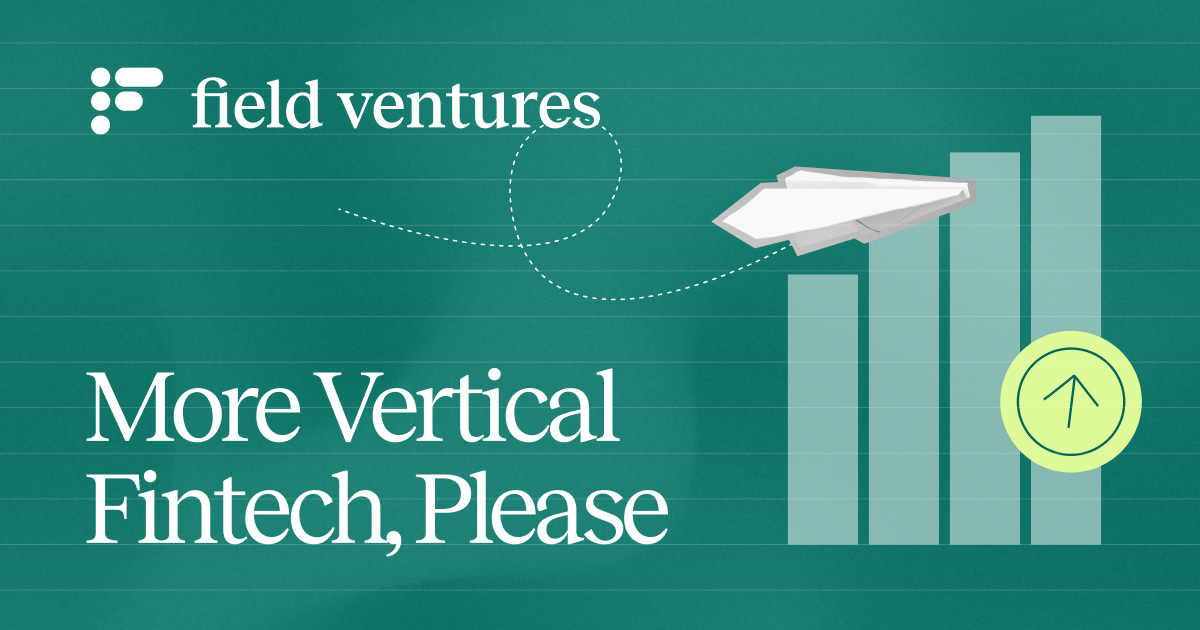More Vertical Fintech, Please
Before generative AI became all the rage, vertical software, and embedded/vertical fintech were all the rage (perhaps it still is for many others as it is for me). At Field, we love investing in vertical software businesses. When properly executed, vertical software leverages the nuances of a given market to improve efficiencies around critical workflows and to aggregate and surface key business insights. The best-in-class examples create a system of record for businesses within the category, while creating substantial enterprise value.
We also love investing in fintech focused businesses; with that said, there isn’t anything inherently defensible about financial services for the sake of financial services. Most pure-play financial services offerings are commoditized offerings. It is extremely difficult to create stickiness with your end customer when the customer can always find a better rate, lower payment costs, or better rewards programs somewhere else.
However, marrying vertical software and financial services can be extremely powerful because of the significant increase in market size that occurs from combining these two product offerings and business models. Workflow software can be quite sticky, but there is always only so much that a business will be willing to pay for software. Conversely, financial services (payments, take rates, insurance, lending, etc.) can be lucrative ways to monetize but tends to have challenges regarding retention.
When executed correctly, the marrying of workflow optimization and financial services create the following attractive business dynamics.
Before generative AI became all the rage, vertical software, and embedded/vertical fintech were all the rage (perhaps it still is for many others as it is for me). At Field, we love investing in vertical software businesses. When properly executed, vertical software leverages the nuances of a given market to improve efficiencies around critical workflows and to aggregate and surface key business insights. The best-in-class examples create a system of record for businesses within the category, while creating substantial enterprise value.
We also love investing in fintech focused businesses; with that said, there isn’t anything inherently defensible about financial services for the sake of financial services. Most pure-play financial services offerings are commoditized offerings. It is extremely difficult to create stickiness with your end customer when the customer can always find a better rate, lower payment costs, or better rewards programs somewhere else.
However, marrying vertical software and financial services can be extremely powerful because of the significant increase in market size that occurs from combining these two product offerings and business models. Workflow software can be quite sticky, but there is always only so much that a business will be willing to pay for software. Conversely, financial services (payments, take rates, insurance, lending, etc.) can be lucrative ways to monetize but tends to have challenges regarding retention.
When executed correctly, the marrying of workflow optimization and financial services create the following attractive business dynamics
Market Traits for Vertical Fintech Success
An example of a market that we think fits this model well is the construction market. The construction market is a massive industry with many stakeholders such as general contractors, subcontractors, material suppliers, developers, etc., all of which have tremendous amounts of spend (hundreds of billions) that flow through them. In addition, general contractors, subcontractors, and material suppliers are all fragmented categories. However, GCs and subs might actually be too fragmented of a segment to focus on. The average GC or sub are very small businesses, which means that one can’t afford to spend any meaningful amount of money to acquire GCs or subs given the low level of monetization that you can capture from them.
Like GCs and subs, material suppliers are also a fragmented group, but not as fragmented, and more importantly, the average material suppliers are much larger businesses and transact with hundreds if not thousands of GCs and subs. This is why I chose the material supplier segment as a sub-category within construction via my investment in Suppli, a payments platform for material suppliers.
Another vertical that we found attractive from a verticalized fintech play was the entertainment industry. There is well over $100B spent annually by production companies across payroll, insurance, and B2B payments within the entertainment industry across film, tv, commercial, and live events. Like the material suppliers within construction, there is fragmentation amongst production companies, many of which are sizable businesses with lots of spend to capture. Lastly, the entertainment industry is unique in that the workers in the space are all contractors and are primarily unionized. This makes it ripe for a vertical fintech business focused on payroll, which is why I led the seed round in Wrapbook, a vertical payroll provider for the entertainment industry. We will share more of our thoughts on vertical payroll opportunities in a future post.
We are certainly not unique in our excitement for vertical SaaS + fintech, but hopefully, this post provides context into how we think the playbook can work across markets. If you are working on a vertical fintech opportunity or want to jam on the space, feel free to reach out!






